Raising Orphaned Wild Baby Birds
I Found A Baby Bird – What Should I Do? Rescuing Them, Raising Them, Their Food & Care
Ron Hines DVM PhD
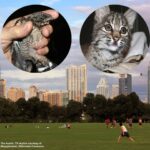 All Of Dr. Hines’ Other Wildlife Rehab Articles
All Of Dr. Hines’ Other Wildlife Rehab Articles
Orphaned wildlife tend to knock more than once at the door of a kind- hearted person. So, for baby cottontail rabbits, go here, opossums here, raccoons, here, squirrels here and here, turtles and tortoises here. Bobcats and other dangerous creatures are best left to professional, but you can go here to see how its done.
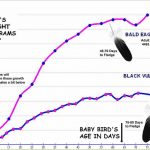 Growth Charts to Plot Their Growth And Progress
Growth Charts to Plot Their Growth And Progress
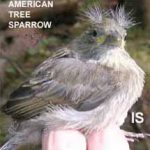
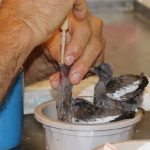
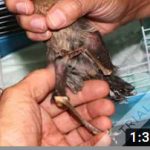
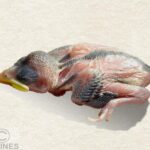
When springtime arrives, many people ask themselves those same questions. The right answer depends on many factors.
1) If the baby bird is not on the ground, leave it alone. As young birds learn to fly, they leave their nests to perch on adjoining branches and nearby bushes. Because it becomes nearly impossible for their parents to supply their enormous food needs, hunger motivates them as well. Their parents go from one baby to the next continuing to feed them through this critical period.
2) Are you sure this bird is a baby? Many sick or stunned adult birds are mistaken for baby birds. Just because it is spring is no guarantee the bird is immature.
3) There are certain species of birds that normally rear their babies on the ground (atricial birds). Killdeer, plovers, shore and sea birds, all duck-like and chicken-like birds are among these. They only need your assistance if they are found in highly inappropriate areas.
Many Sites I See Online And “Rescue lines” Suggest I Leave This Baby Bird Alone Is That A Good Idea Or A Bad Idea?
It is not a good idea or a bad idea.
This is a philosophical question and the right answer depends on what kind of person you are. There is nothing wrong with letting Mother Nature solve her problems in her own way. The baby you just found wasn’t destined by Her to survive. Letting Nature take its course is fine in the grand scheme of things. In the United States, it is also politically correct. But if we all accepted that on an individual daily basis, there would be no need for veterinarians, physicians or good Samaritans.
What Is The Likelihood That This Baby Bird Will Survive If I Leave It On The Ground ?
Very, very unlikely. Here is why:
Ornithologists are scientists who study birds. Their research has shown that, on the average, less than one third of the baby wild birds that hatch will survive their first year and that the majority are lost during their first few weeks of life. For example, studies have found that only 36.7% of Colorado Lark Buntings survive their first 20 days, and only 14-29% of Maryland catbirds or Pennsylvania Hooded Warblers make it through their first eight weeks. (ask me for Adams2009 & Rush & Stutchbury2008)
These are studies of baby birds that stayed in their nests properly. Think how much poorer the odds are for the baby bird on the ground that should not be there. Those with missing feathers, unopened eyes, the weakness of hunger or injuries are certainly doomed; and those that can not or are reluctant to fly to a branch have only slightly better odds – much less than those quoted in those scientific studies.
This is because even well-developed young perching birds (song birds) that find themselves grounded are defenseless against the snakes, raccoons, and other small carnivores that rely on them as their food supply. These critters also have hungry babies to feed at this time of year.
However, most of my readers live in suburban areas. And in suburban areas, the chief destroyer of young song birds are house cats. The number of young birds that house cats destroy is impossible to know with certainty. Cat-lovers tend to minimize the number and bird lovers to maximize it. But the number is undoubtedly huge. (read here) Researchers at the University of Wisconsin have estimate that 20-150 million song birds are killed each year in Wisconsin alone by free-roaming house cats. The US Fish And Wildlife Service estimates 60 million. I personally know from experience that de-clawing cats or placing bells on their collars does little to deter them. Cats catch the birds with their teeth and by the time the bell rings, the cat is already in the air. Even the most pampered, well-fed feline has an instinctive urge to kill small creatures when given the opportunity.
Why Did This Baby Bird Fall Out Of It’s Nest?
There are a number of reasons that this happens:
1) If the song bird’s nest contained a larger, speckled egg at one point, the nest was parasitized by a cowbird. The cowbird chick usually pushes the parent’s true chicks out of the nest as it outgrows them.
2) High winds, storms, tree-trimmers or just poorly anchored nests often come tumbling down or spill out the babies. Baby song birds will also jump or fall from nests that receive too much direct sun or unseasonable temperatures.
3) Older fledglings that aren’t receiving enough food will often leave their nests prematurely. This can be due to the absence of one or both of the parents, an exceptionally large brood or, and most commonly, a lack of enough available insects and other food sources in the area. Some birds, such as barn owls , intentionally hatch more chicks than they could normally raise – in case of a year with an exceptionally high rodent population. The larger, more vigorous chicks push the weaker ones out as they vie for food.
4) Pairs of birds that begin nesting a bit too early, or too late or face unseasonable weather, account for many lost clutches and abandoned nests as does competition from more aggressive bird species. Nesting activity in song birds begins in response to the increased length of days that announce spring with little or no regard for weather or food supply.
5) Song birds and other perching birds that nest in hollow trees are sometimes driven out by more aggressive starlings or English sparrows.
6) Parental distractions, such as their reflection in house windows, bird baths or mirrors or two nests of the same species too close together decrease breeding and fledgling success. This is particularly true for mockingbirds, cardinals, chipping and song sparrows.
7) Toxic problems such as (PBDEs) lead to weak disoriented chicks and low breeding success. But this is seen more in fish and meat-eating birds that feed higher on the food chain, than in song birds that primarily consume seeds and insects.
8) Fledgling instincts out of sync. At the correct time for fledglings to leave the nest, they become “antsy” and restless – a bit like a kid with ADHD or in need of the potty. I assume this is a hormonal thing; but it has never been scientifically studied. I occasionally get in wild bird chicks that display this behavior too soon – before their feathers have “unfurled” enough for them to fly. They are often quite vocal, but do not eat much when food is presented to them in forceps. I assume that chicks with this behavior would be the ones most likely to fall, or bale out of their nest. (The only alternative explanation I can think of would be if the parent birds were feeding the chicks something that contained natural stimulants, but the problem tends to persist. I saw something a bit similar in adult cedar waxwings brought to me after feeding on juniper berries.)
How Old Do You Think This Baby Is?
The age of the baby is something you will only be able to estimate. If you have access to an accurate scale and know what kind of baby bird you have, go to my growth chart page and you can estimate its age from its place on its chart.
If that is not an option, here are some general observations for small songbirds. Not all “songbirds” have a pleasant songs. They are more accurately called perching birds and are referred to scientifically as altricial passerines):
1) If the baby’s eyes are still closed it is probably less than 7 days old. The baby in the photo at the top of this page is a 4-day old mockingbird. If the bird is weak due to stress or disease, it may also be reluctant to open its eyes.
2) By 12-14 days of age it should have most of its feathers erupted but not fully unfurled (still in pinfeather form).
3) By 16-20 days it should be completely feathered , fluttering and interested in leaving the nest.
4) By 22-34 days it should be flying well and able to grasp and eat food on its own although it will still beg its parents for food.
5) By 40–50 days its tail feathers should be as long as its parents. But it may still be dependent on its parents for food.
Another common group of birds are born more mature. They are call precocial birds . Most of them do not have the right shaped feet to perch on branches. They include ducks and geese, shorebirds like sandpipers, killdeer, plovers, ducks, grouse, quail and partridge– but there are many more. These birds are born with a fine coat of down or fuzz and are able to see, walk and feed themselves as soon as they have dried off and rested upon hatching. Precocial birds leave their nest as soon as they are hatched and follow their mother about feeding. The techniques that work for raising babies in this group differ from song birds and so does the food you must offer them.
Should I Put The Baby Back In It’s Nest If I Can Find It?
Returning the baby to its nest rarely works. This is because it probably fell out or left its nest for one of the seven reasons I mentions earlier. Unless you are fortunate enough to be able to correct one of those a reason, the baby will fall again, starve or be eaten. Just putting it back rarely corrects the problem that caused it to fall in the first place.
If the entire nest blew down, you can try to tie or wire it back where it was- or close by to where it was. But parents often abandon such nests. If they are not seen feeding the chicks within 1- 1.5 hours, it didn’t work.
If the baby is close to fully feathered but not yet able to perch, you can place it in a shoe box, woven basket or similar container lined with hay or dry leaves in a safe, elevated, shaded area and wait 1- 2 hours to see if its parents begin feeding it. I look for containers with sides twice as high as the original nest. Another technique that works well for babies old enough to grasp your finger tightly is to place it in a leafy bush with many low and high branches. The thick leaves will conceal the baby from cats, and the many branches allow the baby to gradually hop to the top – out of harm’s way. Its parents will locate it by its cheeping. If the bird is too frightened to stay where you put it – try placing it in the bush or tree again at night. Baby birds are clumsy, hyperactive and excitable.
Baby birds of a younger age are not good candidates for this technique because parent birds do not usually feed younger babies in two different locations.
If the baby is weak, injured, soiled , sleepy, or dehydrated do not attempt to return it. These re-introductions succeed best when the parent birds are still hovering about, concerned about their missing junior. After your attempt, observe only from a distance that does not cause the parents concern.
What If These Babies Are Still in The Nest And Their Mother Has Abandoned Them?
If you suspect that, you yourself may be the cause of the problem. One ought not bother active bird nests. Nesting songbirds do not like to be disturbed. They may appear to accept your presence, but an instinctive response of even a mildly distracted bird is to abandon its nest.
If there are dead chick(s) in the nest it is truly abandoned. Attentive parents quickly throw dead or weakened babies out of the nest. If there are still one or two living chicks, they too will die unless you remove them and see to their care.
If I Have Touched The Baby Bird Will It’s Parents Reject It?
No, they will not reject it because of that. Mammals identify their offspring by their scent. But song birds do not have highly developed sense of smell. They identify their offspring by the noises the baby makes and it’s appearance.
What Is The Difference Between Precocial and Altricial Baby Birds?
The type of birds that have the ability to perch on branches are called passerine birds. These birds are born very immature and helpless with their eyes closed. The scientific term for this immature, helpless state is altricial . Birds that are called song birds or perching birds are all in this group. The feet of altricial chicks have three toes pointing forward and one toe pointing back.
Other birds are born with their eyes open and are capable of walking , following their mother and pecking at food almost from the moment they hatch. These birds are born with a layer of down. The scientific term for this state is precocial. Precocial babies are considerably easier for you to successfully raise than altricial babies.
Most precocial birds make their nest at ground level. Most altricial birds make their nest above ground level (common exceptions are the larks).
What Is The Difference Between A Nestling And A Fledgling?
When a baby bird is still too immature to leave its nest, it is called a nestling. By the time it has acquired enough feathers to fly and the strength to leave its nest, it has become a fledgling. Another defining difference is that nestlings have not yet developed the muscular strength and coordination to perch and grip – while fledglings have. This is Nature’s practical way of seeing to it that baby birds do not leave their nest too soon.
How Should I Safely Hold A Baby Bird?
For right-handed people, baby birds are best held in a cupped left hand and covered with the right hand, as in this photo. Babies capable of jumping, flapping or squirming are best restrained around the lower neck between the right thumb and forefinger.
Do not hold them by their legs or wings. Move slowly and smoothly. Do not make loud noises. Older chicks are calmer in subdued light.
Is It Natural For A Baby Bird To Leave Its Nest Before It Can Fly Well?
It is natural for a baby bird to leave the nest and perch on a nearby branch or object before it gets the full knack of flying. It is not natural for birds that normally perch on branches to be the ground. Being on the ground greatly increases the chances that the baby bird will not survive.
Its flying ability and flying coordination improve rapidly after it leaves the nest. Birds steer with their tail feathers, and their wing flight feathers wont give maximum lift until they are fully developed. So the youngster will remain a clumsy flier until all its feathers have unfurled and reached their full length.
Are There Any Laws That Say I Can Not Care For This Bird?
Yes, there are plenty of them.
Government officials do not care about the fate of any one orphaned wild bird. They care about the fate of wild bird species in general. Laws that are in force in the United States and Europe are designed to protect species – not any one baby bird. It would be very difficult to design laws that made exceptions for the birds that drop out of nests.
As a tidbit to public opinion, and in attempt to make things more manageable, most government agencies make an exception for wildlife rehabilitation centers. However, this is not because they are particularly humane. The US Fish & Wildlife Service requires that all non-endangered wild birds that cannot be made releasable be promptly killed.
Would Taking The Baby To An Experienced Bird Rehabilitation Center Be Best?
Yes, in most cases, these people are better trained than you are.
Baby birds have a very high metabolic rate and they can’t go long without a meal. So don’t dally around. Generally the person in charge at a Center has rehabilitated baby birds for many years. If you have found a baby English sparrow, pigeon or a starling, be sure to get a specific answer as to what they will do with the baby before you leave it off. Also ask for their criteria for euthanizing wildlife.
There are many unrewarded wildlife angels on this Earth. I have known many of them and there countless more. If your little bird survives, help the ones that were not fortunate enough to find you by giving as generous donation as you can to a native wildlife rehabilitation center near you.
All birds with hooked beaks (owls, hawks, eagles) have extremely powerful claws (talons) that will hurt you. They develop strength before the birds leave the nest. Once they have locked on to your body they are extremely difficult to pry off. Herd small ones into a bucket with a broom, or use welders gloves and cover the bucket with a towel so they do not jump out. Place them in a darkened room. Better yet, coral the bird and call an experienced person to come get it.
Fish-eating shore birds such as herons, egrets and cranes have very sharp beaks and an exceptionally long range at which they can spear objects. They can easily put out an eye. Be very careful with them too.
Since About 2016, facing increased pressure from PETA, many zoos and aquariums have tried to recast their images as “wildlife rehabilitation centers” Beware of dropping of native wildlife at these facilities. The primary missions of Zoos and Aquariums is entertainment of the public. Compassion for foundlings is exceeding low on their list of priorities. I know from experience.
How Do I Locate An Experienced Wildlife Rehabilitator?
Call your local veterinarians to get leads on experienced caring folks. Check your state’s Wildlife Department website. Ask your local humane society. Game wardens, animal control officials, police and other bureaucrats can be rather unsympathetic to the plight of individual animals. But many know the folks in your area that have helped them with injured birds in the past.
How Can I Find Out What Kind Of Bird This Is?
All passerine (perching birds) look very much alike before they feather. So it is often impossible to know exactly what you have found. Luckily, knowing exactly what species of baby bird you have is not required to successfully raise it.
You can go to this page and see if you recognize your bird. Be patient as it takes a while to load. If the baby is well feathered, you can also look over over photos on the Cornell Laboratory of Ornithology’s bird identification website . Another excellent resource to identify birds Worldwide are the photo galleries of pBase.com .
Will I Find Any Two People In America Giving Me The Same Advice About Wild Bird Care and Diet?
Probably not.
I do not know of any scientific studies that have compared diets or methods of care for wild orphan songbirds. People will simply relate to you their individual preferences, experiences and successes. This is particularly true when diet ingredients are discussed. That so many different formulas seem work well is a tribute to the adaptability of wild birds. People who devote their time to raising and releasing wild birds tend to be highly opinionated.
If I Decide To Care For This Baby Bird, What Will I Need?
You will need a secluded area. It need not be large, but it should be airy, clean, uncluttered, well-lit and amenable to temperature regulation. It should not be accessible to your pets or children. You will need plenty of time. You will need to get organized and follow a schedule. You will need ingenuity because you will face unexpected situations.
What Should I Keep The Baby Bird In?
Start out with a cardboard shoe box with a small plastic mixing bowl “nest” within it. Little birds like to fit snugly into their nests. This works well until the bird gains enough leg strength to hop out. Then the box must be surrounded by a mesh cage. As the birds mature, they tend to fray their feathers if the mesh is metal (hardware cloth) . If you can construct the outer cage out of vinyl mesh window screen on a wooden frame, you will not have that problem. You will find rolls of it next to the paint isle at Walmart. If you are not a carpenter, you can wrap the screen around the colorful perforated plastic crates often seen behind restaurants or used to hold correspondence files. You can also experiment with a plastic laundry basket. If you do not place a top on it, there will come a time when the bird jumps out. They can be very hard to locate in your house. And sometimes, your pet will find them first. So please make the lid early on. You can also use a second laundry basket, placed upside down over the first one, and hinged with string as a lid. Whatever ends up being your final enclosure, be sure the baby can not fit through the mesh size. Much of their girth of baby birds is fluff and they can squeeze through surprisingly small openings.
Line the “nest” with shredded unscented, undyed, Scott-type paper towels. Grass, hay, leaves and twigs are what wild birds make their nests from. But you will find them messy, sharp, hard to keep clean and quick to become moldy. Avoid thread or string-like bedding or frayed towels that can wrap around the baby’s legs and wings. Change the bedding when it becomes overly soiled or damp. If the nest bowl is the proper . height, the baby bird will lift its butt and poop over the side.
It is very important that the bottom of the baby’s nest not be smooth or slippery. If the birds feet and legs are not well supported, they will gradually splay outward causing a condition called spraddle leg. Birds with this problem are sometimes called “swimmers”.
Baby birds that normally nest in hollow trees or cavities should be kept in a darkened area. It is OK to bring them into the light temporarily to feed and care for.
I do not keep baby birds in an aquarium. It is nice to be able to see the baby, but it is very hard to keep aquaria from becoming too humid or too hot – particularly when you set them up for the first time. By the time you notice that the baby is uncomfortable, it is often too late. However, some wildlife rehabilitators are quite comfortable and successful using aquaria to hold their baby birds.
As soon as the baby is able to grasp your finger when you feed it, it is time to place perches here and there in its cage. The baby will find it easiest to perch on branches that its toes cannot completely surround. Do not use branches that are too small in diameter. Do not use branches with sharp points. Do not place branches in a way that allows them to roll. Scrap them free of poop from time to time or replace them. Do not use the same perches again with subsequent baby birds.
The Importance Of A Low Stress Environment
It is very hard for human beings to recognize when birds are stressed. When you peer down at a robin on her nest, she does not leave or show outward signs of fear. But her heart rate almost doubles and if you repeatedly bother her with your presence she may well abandon her babies. The same applies to baby birds. They do not show immediate outward signs of stress. But the stress causes the bird’s body to releases catecholamines and cortisol which slowly destroy their health.
Some common causes of baby bird stress are:
1) Excessive handling
2) Improper holding techniques
3) Fledgling fear – when the baby is already solidly imprinted on its parents and fearful of humans
4) Predator fear – birds do not like to be peered down at. Approach and hold them at eye level
5) Noisy environment
6) Crowding and competition
7) Lack of required dietary nutrients
8) Improper feeding schedules
9) Wrong temperature or humidity
10) Keeping babies of different ages together
11) Taking on more baby birds than you can adequately care for
What If My Cat Brought Me This Bird As A Present?
Cats derive great enjoyment from catching birds. They often deliver them to their owners with pride, in what appears to be good condition. However, I have had great difficulty in saving these birds. They are usually babies or young-of-the-year that didn’t recognize that they were in danger.
These babies often died suddenly within 12 – 18 hours of being brought to my animal hospital. Many appear to have died of an overwhelming bacterial infection. We know that the mouths of cats harbor many bacteria – among them Pasteurella multocida. We think that these bacteria gain access to the bird through small bites and nicks that may not be readily apparent. No doubt, the stress and terror of being caught in a cat’s mouth plays a part in these deaths as well. Many of these cat-presented babies can be saved with a single timely injection of antibiotics. Water-soluble injectable antibiotic drugs of the penicillin class (but not procaine penicillin) such as amoxicillin and cephalosporins often save these birds. Giving the medicines orally won’t due. Ask a neighborly veterinarian who works with pocket pets to give the injection for you.
How Do I Tell If It Is Injured or Need First Aid Or Emergency Treatment?
Not all veterinarians are qualified to make informed health judgments about baby birds. Veterinary medicine is a very broad subject – too broad for any one person to be competent in all areas. If you bring this baby bird to a veterinarian, bring it to one that specializes in birds, wildlife, pocket pets, zoo medicine or who has a personal interest in wildlife rehabilitation. Your local ASPCA or zoo can direct you to one. There are many dedicated people who care for wildlife who have no formal degrees. Often, their judgment with baby bird problems is as good or better than that of a veterinarian.
The following are some common health problems you might encounter in wild baby birds. This is not an all-inclusive list . It is just a list of some of the more common problems I see in baby wild birds.
1) If you removed the baby bird from a cat or a dog, it needs to be looked at by a veterinarian or a professional wildlife rehabilitator.
2) If it is not alert it needs to be examined by a veterinarian or a professional wildlife rehabilitator.
3) If there is blood on it or in its container, it needs to be looked at by a veterinarian or a professional wildlife rehabilitator.
4) If there is blood or pinkness in its stool, it needs to be looked at by a veterinarian or a professional wildlife rehabilitator.
5) If the baby’s stool becomes mucoid and tenacious or you can not drag a pin through it without the stool mass following behind, it needs to be looked at by a veterinarian or professional wildlife rehabilitator.
6) If it is breathing rhythmically with its mouth open, it needs to be looked at by a veterinarian or a professional wildlife rehabilitator.
7) If its tail feathers bob up and down when it breaths, it needs to be looked at by a veterinarian or a professional wildlife rehabilitator.
8) If it has apparent broken wing(s) or feet or you feel grinding of any sort when you hold the bird, it needs to be looked at by a veterinarian or a professional wildlife rehabilitator.
9) If it has developed its feathers but can not stand or grasp, it needs to be looked at by a veterinarian or a professional wildlife rehabilitator.
10) If the baby refuses to eat it needs to be looked at by a veterinarian or a professional wildlife rehabilitator.
11) If the baby does not steadily gain weight until it leaves the nest it needs to be looked at by a veterinarian or a professional wildlife rehabilitaror. It is normal to loose some weight at fledging.
12) If the baby develops stress bars (hunger stripes) on its feathers or the ends of its feathers break off straightly, it needs to be examined by a veterinarian or professional rehabilitator.
13) If the baby falls to one side or is weak in one leg or wing, it needs to be examined by a veterinarian or professional wildlife rehabilitator.
14) If the baby’s feathers remain fluffed (ruffled) and it shivers, it needs to be examined by a veterinarian or professional wildlife rehabilitator.
15) If the baby bird’s unfeathered skin is excessively wrinkly or shiny it may be dehydrated and needs to be examined by a veterinarian or professional wildlife rehabilitator.
16) If you or your family develop health problems, you need to see your physician and let him know you are caring for a wild baby bird.
17) The most common cause of weakness, apathy and death in baby birds is not hunger – it is dehydration. Baby birds do not handle oral fluids well. I rehydrate them by injection. That needs to be done by an experienced wildlife rehabilitator, veterinarian or health care professional. Hypothermia is the second most common cause of those symptoms they often go hand-in-hand.
What Should I Feed This Baby ?
Despite the varied feeding habits of adult perching birds, all baby birds require similar nutrients to grow and thrive. Perching birds that normally feed on high-protein insects, feed these to their young. But perching birds that normally feed on seeds, fruits and berries also feed insects to their young until they leave the nest. This is because seeds, fruits and berries do not have enough protein content to sustain the enormous growth rate of baby birds.
The exceptions are dove/pigeon-like birds and parrots. They feed partially digested seeds mixed with high-protein secretions from their crops. The other exceptions are birds that feed on fish or small animals and hummingbirds. These groups need tailor-made diets I will write about later.
Precocial birds – the ones that are born with their eyes open and ready-to-go – should be feed the same food items that their parents eat.
If you determine that you have a baby perching bird (other than the exceptions I have mentioned), feed it a diet consisting of approximately 60% soaked, Purina kitten chow, 20% diced hard boiled egg and 20% meal worms when they are available. Birds that do well on this mixture are the ones that have an I, IF, IS, ISF or O in the right lower corner of my photographs. I for insects, S for seeds, F for fruit, O for omnivore. Do not attempt to feed baby seed-eating birds or baby fruit-eating birds only what their parents normally eat. The will not grow and thrive on the diets their adult parents consume.
Cat Foods
Dry Purina Kitten Chow contains approximately 34% protein, 12.5% fat, no more than 4% fiber and adequate (1%)calcium. It also contains all the vitamins that baby birds require. Zoos use diets for baby perching birds that contain 19.5 – 30% protein, 2.5 – 8.2% fat, no more than 2.8-6.5% fiber and 1.1- 1.2% calcium.
Besides Purina, Nestlés corporation also acquired Friskies. Their 5.5 Oz cans of “Savory Shreds” with Turkey & Giblets in Gravy is quite adequate to raise starlings, grackles, mockingbirds, curve-billed thrashers, night hawks and screech owls and has a consistency that is easy to grasp with forceps. When fed wet with the gravy, the chicks require no additional water. Some of these birds that I released on my premises still visit – so they evidently made the transition to natural food sources without serious problems. (In Florida, I had screech owls go from small chicks to egg-laying adults when fed primarily this diet.)
You can use another name brand kitten or puppy kibble that meets the standards of the AAFCO . Chows marketed for puppies and kittens have higher protein, calcium, and vitamin content that products sold for adult pets. I do not use niche-market brands or brands sold only through specialty outlets because small producers don’t have the resources for strict quality control .
Eggs 20%:
Supermarket eggs of any size are fine as one of the ingredients of a home-prepared baby bird diet. Shell color is not important. Hard boil them until the shells peel easily. Save and grind up the shells or substitute one crushed standard Tums-type calcium carbonate tablet for the shell. Whole , shell-less egg is about 26% protein, 1% carbohydrate, 9% fat, zero fiber, 0.5% calcium and 180 ppm iron.
Meal worms 20%:
Meal worm larva are available online . Don’t be squeamish, they eat them in China. They will need to be cut up for little birds. Meal worms are about 20.3% protein, 12.7% fat, 1.7% fiber, and much too low low in calcium as a sole-source diet for wild baby birds.
There are a lot of negative sentiments against feeding earthworms. Earthworms contain whatever pathogens the soil they burrowed through contained. But this fear is primarily based on a particular parasite earthworms sometimes carry called Syngamus trachea, which they ingest as the burrow along in the poop from previously infected birds. Worms you grow in your organic garden are probably fine – but their protein and gross energy content is considerably less than meal worms.
What If I Feed The Baby Bird The Wrong diet?
It is the wrong diet only if its nutrient content differs substantially from the ones I gave. There are many ways to get to a good nutritional diet – you will find oodles of recipes on the internet and many of them are just fine. Some people who care for orphan baby birds have their “lucky” formulas with a pinch of this and a smidgen of that. Working with large numbers of baby birds while running an animal hospital, I try to keep my list of ingredients short.
Diets too low in protein (less than 28%) can result in stunted grows, delayed development, poor plumage, listlessness, swollen bellies and increased susceptibility to disease. But too much of a good thing can be bad too. Too high a protein level in the diet can lead to kidney damage and gout. Too low a calcium level or too high a phosphorus level will lead to soft bones and rickets.
Baby birds do not handle milk sugar (lactose) well. So do not give your baby bird any products containing milk, lactose or dairy.
Bread and pasta products are “empty” calories. They should only be given to birds to dilute out other ingredients – not to birds on a well-structured diet.
What Should The Food Consistency Be When I Feed It?
You can alternate feeding bits of moistened kitten chow, egg and meal worm. I don”t mix the chopped egg with the moistened kibble – because it tends to fall off the tweezers.
I run the kitten chow through a crank meat grinder before I add water. But you can just cover the chow with water and place it in the refrigerator until the formula becomes soft. Once it is soft, it should be heated to 160 F (71C) to destroy bacteria, such as salmonella, and then allowed to cool to 95 F before it is fed. If you reheat the formula, beware of microwave hot spots that will scald the baby’s mouth and throat.
You can make a few days batch, freeze it in an ice cube tray and store it in ziplocks. Thaw only the cubes you are about to use. It is not freezing that destroys nutrients; it is repeated freezing and thawing.
You would like the feeding consistency of the chow to be as moist as possible and still be able to pluck up bite size portions in a pair of plastic tweezers. Thicker than oatmeal – thinner than mashed potatoes.
Chop the hard boiled eggs into pieces small enough for the baby to swallow without a fuss. Do the same with the meal worms.
How Much Should I Feed?
The safest thing to do is to weigh the baby frequently on a diet or postage scale. It must gain weight every day until it is ready to fly.
As a rule of thumb, baby songbirds double their hatching weight within 4-6 days of hatching. That rapid weight gain should continue for the next two weeks. During this period, baby birds generally eat about 10–15% of their body weight per feeding. For example, a 37 gram baby might eat 3.7-5.5 cc of moist diet (3/4 – 1 teaspoon). This is only a rule of thumb. Always continue the feeding until the baby only responds halfheartedly to stimulation.
Do not attempt to feed them that very last morsel that they will halfheartedly accept. If you are concerned with slow weight gain, it is safer to increase the frequency of your feeding rather than the feeding portion size.
When babies gain weight slower, or don’t gain at all, there is a problem. It can be the first and only sign that you have a problem before it is too late to do anything about it.
How Often Should I Feed ?
Naked, unfeathered babies with closed eyes need to be fed every 15-20 minutes from sunrise to sunset.
Once their eyes have opened and their feathers are sprouting, you can drop to feeding every 30-45 minutes. As they grow, slowly increase the amount you feed them at each feeding and stretch the interval between feeding. The baby will help tell you – when it isn’t hungry, it will not open its mouth or it will sling the food morsel out. By the time it is hopping out of the nest, it can be fed every hour. As it becomes more confident out of the nest, reduce the feedings to every 2-3 hours. By that time, it may show a bit of interest in food items placed in its cage.
What Is The Best Feeding Technique?
You do not need to worry about food going down the wrong way. Baby birds can swallow remarkably large objects. As soon as the object is in their mouth, their glottis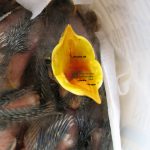
locks shut, preventing them from inhaling the food into their lungs. This reflex does not work well when the food you feed is too liquid.
I like to feed songbirds with disposable plastic forceps . You can carve the ends with an Exacto™ knife or razor blade to the approximate size of the adult parent’s beak. Flame polish the carved surface with a lighter so it does not have sharp edges or a point. I only use syringes to feed pigeons, doves and parrots the soupy formulas they require
Older babies, stubborn ones and weak ones may be slow to initially accept food from you. Be patient. Rub the forceps gently along the birds beak, jar their “nest”. That usually stimulates them to open their mouth (“beg” or “gape”).
 How Fast Should My Baby Bird Grow?
How Fast Should My Baby Bird Grow?
Look through the growth charts I have drawn for some common foundlings to get an idea how fast your baby bird will grow. Your baby will not grow exactly as the charts predict. The explanation why that is, is on the chart page following the graphs themselves. Some of the birds I have graphed are definitely not songbirds. Do not attempt to raise any of these larger birds yourself.
Pigeons and Doves
Read abour raising them in detail here. Baby pigeons and doves parrot-like birds are a special cases. They place their bills inside their mother’s mouth, which causes her to regurgitate a mixture called “Pigeon milk”.
They are best fed with a 3 ml plastic disposable syringe with the needle removed. I usually ream out the diameter of the needle end of the syringe with a 1/8” drill bit to make the formula flow through more easily. If not, the formula needs to be liquefied in a blender. If you boil a 2.5-inch section of clear IV tubing, you can work it over the end of the syringe. Shorter sections of tube that work loose are sometimes swallowed by baby birds.
Rolling the baby’s soft beak gently between your thumb and forefinger will usually begin it’s wing trembling and drinking response. Do not overfeed these birds. Feed slowly. Stop feeding just before the level of milk in their crops reaches the base of their neck. Do not feed again until their crop is empty. Be sure the formula is not too hot or it will scald through the crop wall.
Pigeon formulas hardens like cement. So after you finish feeding, clean off the birds beak and neck feathers with a dampened Kleenex.
Pigeons and doves do well when fed Kaytee Exact – hand feeding formula for parrots.
They also do well on a mixture of commercial feed store turkey starter and water. Mix one part starter with an equal volume of warm water. Blend it to soup-like consistency and let it stand in the fridge. After a time, it will thicken up. Then add more water and blend it again to a soup like consistency. You can make ice cubes from it and store them in the freezer. Feed the thawed or fresh mixture at about 85-95 F.
I do not like to purchase turkey starter by the scoop-full from uncovered bins because of rodent contamination problems. Chicken starter will also do. You can use the large part you won’t be using in your bird feeder.
Because doves, pigeons and parrots store a large volume of food in their crop. They do not need to be fed nearly as frequently as other bird species.
Should I Provide Water?
The only time I give water to immature birds is when they come to me in the spring and summer time dehydrated. That is quite often the case. In those situations, the only safe way to give them fluids (D5W or Ringer’s) is subcutaneously with a 26 gauge hypodermic needle. If you feed dehydrated birds oral food, it will not pass down their esophagus well – nor will it be digested.
Not until the baby bird is walking or perching. Never give it water or watery fluids by mouth. If it is dehydrated, it needs the fluids by injection. Dehydrated birds are too weak to absorb fluids through their stomach and intestines. When given orally, it usually just passes down into their lungs.
Once the bird is perching or walking in its cage, place several shallow containers (jar lids) of water and change them frequently. Place a clean stone in the center of the lid so they do not stand in it or tip it.
What About Parasites?
Read about parasites in detail here. Parasites are only an problem in social nesters. Examine pigeons, swallows and other community nesters closely for body mites. They are very tiny. If you begin to itch – check them again.
If you locate any, the safest approach is to pick them off with tweezers and drop the unwanted critters in a small glass of rubbing alcohol. At the same time, you will need to change everything out in the baby’s cage or boil it. Also, hose the cage out well.
When pigeons or doves are found with developed feathers, pigeon flies can be a problem. They are fast! Any water-based kitten/puppy flea spray that contains only pyrethrins and pipronyl butoxide can be applied to baby pigeons sparingly to kill these critters. It works well on all surface parasites except ticks.
Over the last few years, I have been getting in a large number of injured pelicans and gulls. All of the sea birds and some of the raptors come in with large numbers of feather mites. They get on my staff and me. They are annoying, but they do not bite. They just chew feathers. My treatment is to buy a bag of cornstarch and a bag of 5% Sevin™ Dust and mix them together 50-50 in an old Garlic Salt container. A light dusting along the spine quickly rids them of these mites. I have never encountered mites on the offspring of birds that do not nest in groups.
Does This Baby Bird Need A Vitamin Supplement?
No. If you are feeding one of the diets I suggested, no added vitamins or minerals are needed.
Do I Need To Provide Grit?
Not until the baby is eating whole seeds. Birds do not need grit when they are eating a diet that is already ground up. Read more about grit here.
Do I Need To Accustom The Baby To It’s Natural Diet Before I Let It Go?
Yes.
Much of your bird’s preferences in food are instinctive. But you will give it a head start if you accustom it to eating the things it will normally feed on in the wild. For birds that will primarily feed on insects, place meal worms, crickets and other small critters in its cage. Leaving the light on, on your front porch should attract a number of food candidates. Don’t feed ants or indoor cockroaches. Things living under flagstones are usually fine. It will be hard work locating enough insects to meet the youngster’s needs. So, it is OK to also offer supplemental moistened kitten chow crumbles.
For seed-eaters, a fortified cockatiel seed mix works well. Supermarket wild bird seed is not a suitable diet. Seed-eaters must have grit. The best is ground oyster shell. You will need to crush it with a hammer as it is sold too large for songbirds.
A mixture of diced fruits works well for birds that normally eat fruits and berries. Do not include avocado.
It will be slow going, because it is hunger as much as curiosity that motivates baby birds to feed on their own. That fledgling hunger is what causes the dip in their growth curve just before they leave their nest. With you as an ever-present source of lunch, they don’t have their normal motivation.
Do not stop feeding them “cold turkey” – just gradually cut back.
Does The Baby Need Quite Time and Sleep?
Yes, the room it is kept in should be dark when it is dark outside.
What Should I Keep The Temperature Set At ?
Before baby birds are well feathered, they are very susceptible to chilling. This is because their body surface is very large in proportion to their body weight and because they lack insulating feathers.
Small songbirds bodies operate a much higher temperature than yours. The average human body temperature is 98.6F. That of an English Sparrow is about 105 F. Once the baby is well feathered, it can maintain this high body temperature using its food calories as fuel. But before it is fully feathered, it needs you to keep its temperature up. You can do this with a heat lamp. Buy an aquarium thermometer. I like to keep baby birds at 95-97 F for their first week of life then dropped 5 degrees per week until the baby has fledged.
It is very important not to overheat the baby. To prevent this, you need an aquarium thermometer places next to the infant bird and you need to spend a lot of time in the setting up. Check the thermometer temperature frequently. Drafts can cause an inaccurate reading. If it gets too hot, altricial babies can not move away from the heat as little chicks and other mobile precocial babies can.
Some folks are more comfortable using a heating pad under the baby’s container set at its lowest setting. If you use a heat lamp, be sure it is not a Teflon-coated shatter-proof bulb. Hair dryers can also be a source of toxic Teflon. I find than an ordinary 40 watt light bulb placed in a tin can works quite well.
The acceptable temperature range for baby songbirds is a narrow range. Too high a temperature will cause them to dehydrate. If you are very careful to avoid fire hazard, you can drape a towel over the cage to help hold in heat. Too low a temperature leads to digestive upsets and infections. Chilled baby cannot digest their food.
What About Humidity?
The wild birds that nest in your area have adapted to your local humidity levels. You only need to adjust humidity if your house is air-conditioned or you run dehumidifiers. Air conditioners lower room humidity. If you cover the bird’s cage with a towel, you can keep one end of it dipped in a bowel of water outside its cage. Close the AC vent to the room will also help, as long as it does not become unbearably hot.
What About Lighting?
Baby birds do best in natural sunlight or a full-spectrum substitute. If a potted Philodendron does fine in the room, the baby should do well too. Baby birds need UV light to manufacture their own vitamin D. Full wavelength lighting probably also helps them learn to eat more rapidly on their own. However, the cat chow and turkey starter you are using are fortified with enough vitamin D to meet your baby’s needs.
 Can I Tell A Male Baby From A Female Baby Bird?
Can I Tell A Male Baby From A Female Baby Bird?
I cannot do it and there is really no reason to know.
When you have more than one juvenile songbird, the larger ones tend to be the males. In hawks and owls, it is reversed – the larger ones are usually females. Feather colors do not differ until the bird’s matures. There are DNA and laparoscopic techniques – but they don’t apply here.
Concerning the chicks of raptors and owls, female chicks are slightly larger than male chicks of the same age. The difference is most noticeable after a week. However, birds like barn owls have a staggered hatch. That is, the hen owl begins to sit on the first eggs laid before she lays the remainder of her eggs. The I rarely have a clutch of owlets brought to me that are all the same size. As time goes by, the size difference due to staggered hatch disappears. After that, size reliably indicates sex.
 What Are Some Common Problems I Might Encounter In Raising Wild Baby Birds?
What Are Some Common Problems I Might Encounter In Raising Wild Baby Birds?
Sometimes, baby birds are just too weak to survive when you find them. The smaller, unfeathered ones are just too fragile to survive long without food or proper temperature. If you encounter a baby in that condition, bring it to a bird rehabilitation center or a kindhearted veterinarian and hope for the best.
If you follow my suggestions as to diet and environment, the most common remaining problem is not using a well enough constructed cage and having babies hopping out, getting lost in the house, underfoot or caught by your pets.
Spraddle leg can occur if the bird must stand on a slick surface. Hopelessly tame babies are hard to successfully release. Too small a cage leads to worn and broken feathers.
 Will This Baby Bird Learn To Fly On Its Own?
Will This Baby Bird Learn To Fly On Its Own?
Yes.
A baby bird’s ability to fly is instinctive. It just wont happen as quickly in a bird you raise by hand. You will need a spacious flight cage, screened gazebo or a screen porch – don’t let baby birds fly around your house. Open toilets, ceiling fans, mirrors windows and lit stoves are all major hazards.
When Should I Release This Baby Bird?
The first week after release is the most dangerous for hand-raised baby birds. The time to release baby birds is when they are eating well on their own and capable of confident flight.
The biggest problem is that many baby bird species are fed by their parents for months after they leave their nests. I don’t have an easy answer for this – just do what you feel is best. I take city birds to a large park and release them there. In Chicago, I took them deep into the Forest Preserve, in Sarasota, FL, I released them on large tracts of county-owned land. If this is a suburban bird, leave it’s cage door open and its food bowl full and let it decide when not to return. In Northern Israel, I had barn owl chicks return every night for food for over 6 months.
What Is Imprinting And How Will It Affect This Bird’s Future?
All animals decide what they are during their first few weeks of life. That means, whoever feeds them is what they think they are. This is called imprinting. Imprinting as a human can make life very hard for a baby bird. It can be a big enough problem so as to make successful release impossible.
For that reason, handle your little bird as little as possible. Keep their cage area screened of from passing people in the house. Do not expose them to the sight of pets or children. Babies of birds that can walk from birth are particularly susceptible to imprinting on people. It is also a bigger problem in species of birds that form flocks.
This mis-imprinting on humans is contrary to the inborn, genetic tendency of birds. So with time, it becomes less and less of a problem – if you do not reinforce it with human contact.
What Should I Feed Birds That Normally Eat Fish?
The babies of fish-eating birds (those that live near water) need to be feed a diet of fish. The fish needs to be brought to room temperature, minced into appropriately small sizes and fed with forceps. Fish from the supermarket will not do. The baby needs to consume all the parts of the fish – bones, guts and all – in order to receive all of the nutrients it requires. Fishing bait stores are a good source of minnows. Ask for the ones that bellied-up in the tanks and were moved to the fridge. It is OK if these fish are frozen – but not if they are stale. Stale fish do not have enough thiamine and they contain rancid oils that are unhealthy to the baby birds. I freeze them all to destroy the parasites they sometimes contain.
What Should I feed Birds of Prey?
Small owls and hawks normally eat insects as well as small rodents and birds. Their menu items get larger as their species size increases. To thrive, these birds need to consume all of their prey. What they don’t utilize, they will cough back up as a casting.
You can purchase appropriately sized rodents and frozen chicks from Rodent Gourmet and appropriate insects from Grubco. Local snake people will know where to find them. These birds need to learn to hunt in order to survive. As they mature, their food needs to be offered to them alive. This is a really gruesome business and not for everyone. You can’t just drop in the rodent – you need to stay and be sure it does not bite the bird. That is why I suggest you drop these youngsters off at rehab centers when you find them.
What Should I Feed Chicken-like Birds (gallinaceous birds)?
All gallinaceous birds (chukars, pheasant, peafowl, quail) do well on turkey starter or game bird starter. They need a shallow water dish from day one. Fill it with marbles so they don’t stand in it.
What Should I Feed Baby Ducks and Geese?
They also do well on turkey starter and wild game bird starter. They need a shallow water dish from day one. Fill it with marbles so they don’t stand in it.
What About Shore Birds and Killdeer?
Plovers, avocets and killdeer do well from day one on a diet of mixed insects and crustaceans that are appropriately small for their size. They also enjoy tubifex worms you buy at a pet fish store and the small sea life you find under the kelp when the tide recedes. You can add pieces of minced, hard boiled egg and shrimp. Remember, these birds need a water dish from day one. I fill it with marbles to keep the birds from standing in it. Place the food items in a very shallow tray of water. Do not allow them to become stale.
What Should I Feed A Baby Hummingbird?
Hummers do well on Nektar-Plus™. They will not live more than a few days on the hummingbird food sold in supermarkets. There are some home-made formulas, but I have no experience with them.
Can My Family Or I Get Sick From Handling This Baby Bird?
Yes.
Such a thing have happen. But they probably won’t if you and family members have a healthy immune system. Public health and wildlife regulatory officials use this excuse to try to talk you out of helping the bird.
Orphan baby birds are not play things. They are not toys. They are fragile. Purchase stuffed animals for your kids, not live ones. Besides, the immune systems of children are fragile as well.
Adopting and caring for wild baby birds is also not a good idea if you or members of your household are fragile elderly folks, if you have pre-existing health problems that weaken your immune system or if you are on chemo. It is also not a good idea for people with asthma, emphysema or other lung problems. Bird dander is unhealthy to inhale. (pigeon breeder’s lung)
Birds that do not nest in large groups are not a significant source of disease that can infect humans. Avian flu is only a significant problem in migrating waterfowl and domestic chickens.
Breathing in bird dander can be a problem. Dust and dander are worst when feathers are sprouting. So be sure that your home is well ventilated and that you use the most efficient air filters you can find on your heating/AC ducts. Cleaning with an ordinary vacuum cleaner just moves fine dust particles into the air where you will inhale them. Lung problems caused by bird dander are called pigeon lung disease . I added the Wikipedia link earlier. This problem, when it occurs, is worst in individuals that smoke. But it can affect anyone.
There are a number of infectious agents that are not very particular as to whether they live in a bird, other animals or humans. If you are a worry wart, they include salmonella, the organism that causes parrot fever, cryptosporidium, avian tuberculosis, campylobacter and giardia. I have been caring for orphan baby birds since I was 11. That was half a century ago. I do not know of anyone who was seriously injured by a disease they caught from a fallen baby bird. Wildlife rehabilitation centers and the people that run them face their own unique health hazards because they are generally understaffed, under funded, overcrowded and overwhelmed with seasonal babies and injured and sick wildlife of every kind.
Are There Some Steps I Can Take To Minimize Potential Health Problems?
1) Do not keep orphan wild birds in your kitchen, near food storage or in high traffic areas
2) Wash your hands before and after handling wild birds or cleaning their cages. You are just as likely to infect birds with unhealthy bacteria as they are to infect you. Better yet, wear disposable gloves when tending to your orphan. If you don’t, rinse your hands with 70% isopropyl alcohol after you have handled them. Do it where the fumes will not intoxicate the bird.
3) Store refrigerated items in well-sealed containers.
4) After removing soiled material, dip all utensils in a mixture of one part household bleach and twenty parts water. Then air dry them thoroughly before you use them again. Bleach does not work well when thick grim is present.
5) Keep the bird on shredded newspaper or plain, untreated absorbent paper towels and change them daily.
6) Be clean. Fallen food attracts rodents. Wild mice and rats carry diseases that can affect you and the baby bird.
7) Do not mix sick birds with healthy birds and care for the sick ones last.
8) 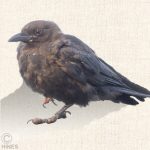


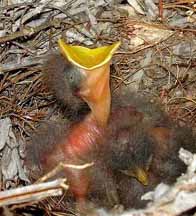
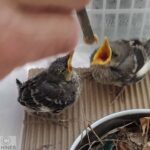
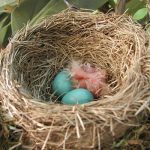

 How Fast Should My Baby Bird Grow?
How Fast Should My Baby Bird Grow? Can I Tell A Male Baby From A Female Baby Bird?
Can I Tell A Male Baby From A Female Baby Bird? What Are Some Common Problems I Might Encounter In Raising Wild Baby Birds?
What Are Some Common Problems I Might Encounter In Raising Wild Baby Birds? Will This Baby Bird Learn To Fly On Its Own?
Will This Baby Bird Learn To Fly On Its Own?